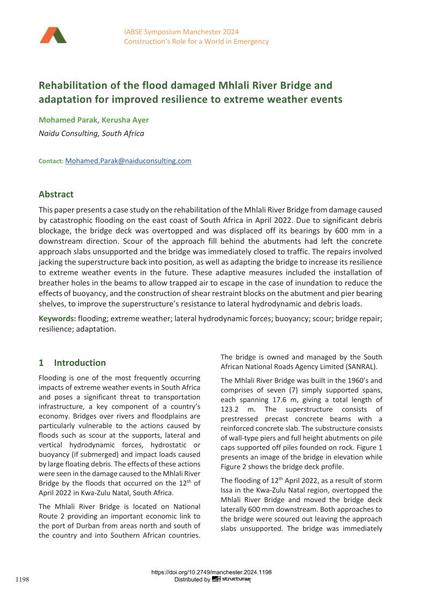Rehabilitation of the flood damaged Mhlali River Bridge and adaptation for improved resilience to extreme weather events

|
|
|||||||||||
Détails bibliographiques
| Auteur(s): |
Mohamed Parak
(Naidu Consulting, South Africa)
Kerusha Ayer (Naidu Consulting, South Africa) |
||||
|---|---|---|---|---|---|
| Médium: | papier de conférence | ||||
| Langue(s): | anglais | ||||
| Conférence: | IABSE Symposium: Construction’s Role for a World in Emergency, Manchester, United Kingdom, 10-14 April 2024 | ||||
| Publié dans: | IABSE Symposium Manchester 2024 | ||||
|
|||||
| Page(s): | 1198-1205 | ||||
| Nombre total de pages (du PDF): | 8 | ||||
| DOI: | 10.2749/manchester.2024.1198 | ||||
| Abstrait: |
This paper presents a case study on the rehabilitation of the Mhlali River Bridge from damage caused by catastrophic flooding on the east coast of South Africa in April 2022. Due to significant debris blockage, the bridge deck was overtopped and was displaced off its bearings by 600 mm in a downstream direction. Scour of the approach fill behind the abutments had left the concrete approach slabs unsupported and the bridge was immediately closed to traffic. The repairs involved jacking the superstructure back into position, as well as adapting the bridge to increase its resilience to extreme weather events in the future. These adaptive measures included the installation of breather holes in the beams to allow trapped air to escape in the case of inundation to reduce the effects of buoyancy, and the construction of shear restraint blocks on the abutment and pier bearing shelves, to improve the superstructure’s resistance to lateral hydrodynamic and debris loads. |
||||
